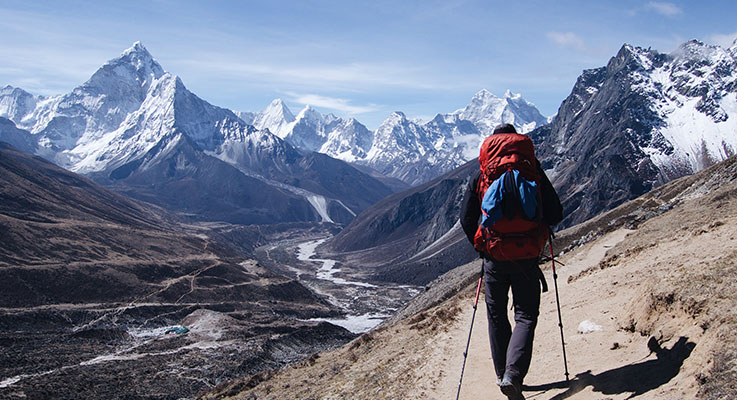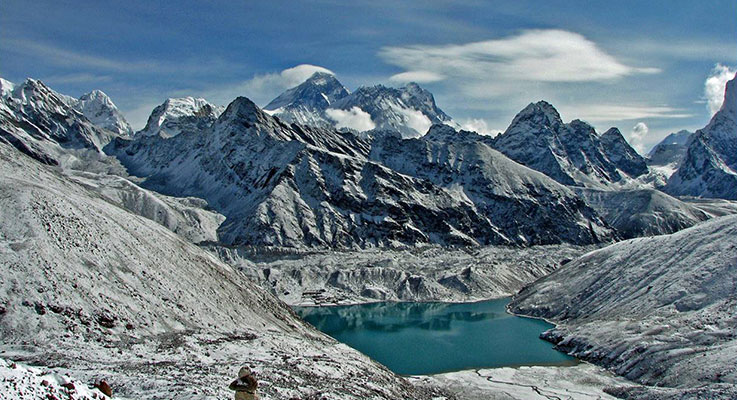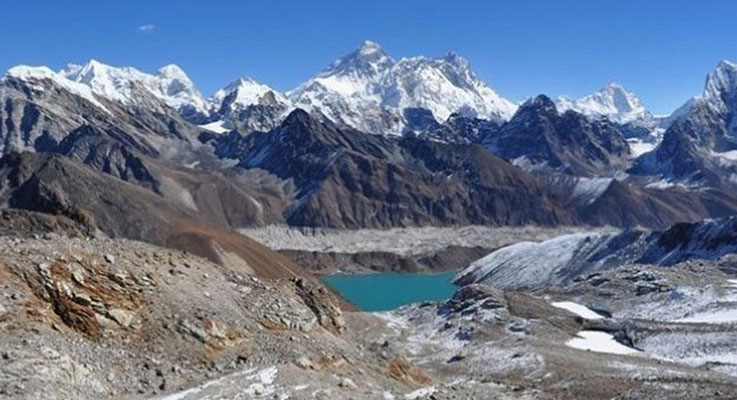-
Day 1
Arrival in Kathmandu (1,345m/4,413 ft)
Upon arriving at Tribhuwan International Airport in Kathmandu, you will be received by our airport representatives who will warmly greet you and transfer to the hotel on a private tourist vehicle. We provide 3-star accommodation in the city and we arrange for a trip briefing with dinner in the evening.
-
Day 2
Visit old town of Kathmandu
A professional guide and vehicle are provided for a day of sightseeing in and around Kathmandu city. We visit some of the UNESCO World Heritage Sites in the city along with other interesting cultural monuments that dot the valley. These include Boudhanath Stupa (the largest Buddhist shrines in the world), Pashupatinath (the holiest Hindu temple in the world), Durbar Squares (Palaces and fortresses of medieval Kings), along with other popular cultural attractions. We get to observe the lifestyle of Nepalese people, holy sadhus and monks, fascinating history as well as awe-inspiring architecture.
-
Day 3
Fly from Kathmandu to Lukla (2,800m/9,186 ft). Trek to Phakding (2,610m/8,563 ft)
Early in the morning, you will be transferred to the airport in Kathmandu for a scenic 30-minute flight to Lukla. The airport guide will brief you and introduce our porters before we begin our trek towards Phakding (2,610m). There will be some time to explore the village while our Sherpa crew sorts and loads trekking equipment and baggage. The trek starts with a descent to Dudh Kosi River, from where the wider trail leads us to the village of Ghat (2,550m), and then to Phakding on an easy-paced walk.
-
Day 4
Trek from Phakding to Namche Bazar (3,440m/11,286 ft)
Walking along the shores of Dudh Kosi, we get to cross the serene river many times on exhilarating suspension bridges decorated with prayer flags. A little further, we enter Sagarmatha National Park from where the trail climbs steeply with picturesque sights. After trekking for a few hours, we reach Namche Bazaar, known as the Gateway of Everest.
-
Day 5
Namche Bazaar acclimatization day
In order to acclimatize to the altitude gained and thinner air, we spend a day in Namche Bazaar. There are several quality restaurants, hotels, lodges, shops, money exchange services, internet cafes and bakeries at this town, also the largest in the Everest region. We pay a visit to the museum nearby known for its traditional artefacts that showcase the Sherpa culture. We also hike to Syangboche Airport from where we can see rewarding vistas of stunning sunrise and sunset over the Himalayan panorama.
-
Day 6
Trek from Namche Bazaar to Deboche (3,800m / 12,467ft)
We ascend out of the village and follow a high, fairly level path above the Dudh Kosi enjoying spectacular mountain views of Everest, Nuptse and Lhotse as we go. We pass the various shops set up by Tibetans selling trinkets and then descend through forest of blue pine to cross the Dudh Kosi again at Phunki (3,250m). We make another ascent on a switchback trail, sometimes made quite dusty by yak trains, to reach the spectacularly sited Thyangboche Monastery (3,867m) from where there are brilliant views of Everest, Lhotse, Nuptse, Ama Dablam and Taboche to the north and northeast, Thamserku and Kantega to the southeast and Kwangde to the southwest. Thyangboche Monastery was seriously damaged by fire in 1989 but has since been rebuilt and there will be time to visit both the monasteries and a museum. We reach our teahouse at Deboche. 6 hours walk.
-
Day 7
Trek from Deboche to Dingboche (4,350m/14,272 ft)
We descend through meadows and rhododendron forest, past the Buddhist nunnery at Deboche, to the Imja Khola. Then up along the north bank of the river, with spectacular views of AmaDablam, to a teahouse at Orsho. Crossing the confluence of the Khumbu and ImjaKholas we continue to Dingboche (4410m). 7 hours walk.
-
Day 8
Dingboche acclimatization day
A day for acclimatization and exploring: you can do a day’s walk up the Imja Khola valley through Bibre at 5,060m to the yak huts at Chukhung. Here are good views of the east face of Ama Dablam and the Lhotse-Nuptse wall. Or you can walk north, up along the valley side to the ruined Nangkartshang Gompa, or continue up to nearby Nangkartshang peak with its fantastic views. 5 hours walk.
-
Day 9
Trek from Dingboche to Chukhung (4,710m/15,453 ft), back to Dingboche
A day’s walk up the Imja Khola valley through Bibre at 4,570m to the yak huts at Chukhung and on to a small view point above at 5,546m to the Chukkung Ri. Here are good views of the east face of Ama Dablam and the Lhotse- Nuptse wall. About 8 hours walk.
-
Day 10
Trek from Dingboche to Lobuche (4,910m/16,109 ft)
We start 6 am after Breakfast and with Pack Lunch towards the pass, a gentle strong along the valley at first, followed by a steep ascent into the deep valley between Pokalde Peak and Chhukung. This will be a big day as we ascend to the Kongma La pass (5530m) amid the crags of this outlying ridge from nearby Nuptse. From the pass we descend steeply to the Khumbu Glacier which we cross, clambering up the moraines on the far side to reach the meadow by the Italian high altitude research pyramid where we plan to camp the night. The difficulty of today's trek should not be underestimated, particularly in snow conditions where the trek across the glacier at the conclusion of the day can be quite exhausting. About 8 hours walk. Lobuche (4910m)
-
Day 11
Trek from Lobuche to Everest Base Camp (5,365m/17,602 ft) and to Gorakshep (5,180m/16,995 ft)
This morning we will have an early start and head up to Everest Base Camp itself. Our trek starts with a gentle ascent initially which later develops into a steeper ascent of about half an hour. A descent back down then brings us to Gorakshep (5150m) where we will check into our lodge. The trail splits at this stage and goes to the small peak of Kala Pattar one way and Everest Base Camp in the other. We will take the Base Camp route and head up to take a look. There may be the possibility to meet climbers and their crew at the camp on their way up the mountain. Once we have explored the Base Camp and seen all it has to offer we will retrace our steps back to GorakShep where we will spend the night.
-
Day 12
Trek from Gorakshep to Lobuche (4,910m/16,109 ft)
Taking the other route today we have a steep ascent, which brings us to the top of Kala Pattar (5545m). From here, on a clear day, we will have the opportunity to see the breath taking views of the surrounding mountain peaks; Mount Everest, Nuptse, Lhotse, Ama Dablam, Kangtega, Thamserku, Tawache, Pumori Gyachung Kang plus Khumbu Icefall and Glacier. After taking in this fabulous sight we will head back down again back to Gorakshep and on to Lobuche for our overnight stay. 6-7 hrs walk
-
Day 13
Trek from Lobuche to Dzonghla (4,710m/15,453 ft)
We head west towards the Cho La Pass, contouring around a head and towards the picturesque Dzong La Pass which cuts across a jagged spur that descends from the summit of Lobuche Peak. The path takes an obvious, gently ascending line, but is very narrow and in snowy conditions can be slippery. High on the flanks of Lobuche we will lunch beside a glacial lake before a long descent to a magnificent settlement at the foot of Cholatse, near the base of the Cho La pass. About 4-5 Hours walk. Dzongla 4830m. For those who feel up to it, there is an optional climb of Awi Peak at 5245m
-
Day 14
Trek from Dzongla to Tagnag (4,350m / 14,272ft)
Trek over Chola La (5,430m) Tagnag at 4,800m, 7-8hrs. The views today are magnificent as we leave the Everest watershed and enter that of Cho Oyu, the sixth highest mountain in the world. The crossing is hard work, involving a steep scramble up rock boulders and then a walk across the gently ascending, snow-covered glacier that caps the pass. However, the views of the route ahead, and of the glacier itself, are breath-taking. We descend steep boulder strewn slopes to the Gokyo valley below. This is a valley of turquoise lakes and great glaciers. For the first (and steepest) part of the descent there are discernible paths that zigzag down the mountainside - slippery in snow! The ground then levels out and the path all but disappears as we hop across a field of boulders. Finally we climb a gentle slope to the top, from where its all downhill (for today at least!), following a narrow river valley all the way to its base where we stay overnight at Tagnag, a small Sherpa settlement nestled beneath great rock walls, just a stone's throw from the Ngozumba Glacier
-
Day 15
Trek from Tagnag to Gokyo (4,790m/15,715 ft)
We cross the glacier and ascend the lateral moraine valley past beautiful lakes with Siberian ducks Swimming across the mirror-calm surface, to the village of Gokyo 4,790m. An easy day.About 5 hours walk.
-
Day 16
Hike from Gokyo to Gokyo Ri (5,438m/17,841 ft) and back to Gokyo (4,790m/15,715 ft)
Again we make early start to get the best views. Crossing a stream we make a long steep ascend to the small peak called Gokyo Ri to the northwest at 5,360m. Excellent views from here of Cho Oyu, Everest, Lhotse, Nuptse and Makalu. About 6 hours walk.
-
Day 17
Trek from Gokyo to Lungden (4,300m / 14,108ft)
The days walk is rewarding as the top exposes the view of Everest massif in the east, Rolwaling Himal in the west with other snowy peaks towards north. An early morning start for the steep climb up to the Renjo-la pass (5,345m) before descending to the settlement of Lungden 4380m. There is a chance we will meet Tibetan Traders descending from the Nangpa La pass that leads through the Himalayas from Tibet with their caravans of woolly yaks laden with goods. About 7 hours walk.
-
Day 18
Trek from Lungden to Thame (3,800m / 12,467ft)
We walk for about 4 hours through a stunning landscape on an old trade route to Tibet to the village to Thame, the birthplace of Tenzing Norgay Sherpa, the first man to summit Mt. Everest along with Sir Hillary.
-
Day 19
Trek from Thame to Monzo (2,825m/9,268 ft)
Our trail today first descends to the river before hiking on the gradual and beautiful trail towards the village of Namche. The trail then descends to join the main trail to Namche Bazaar. After lunch we descend even further to Monzo (2840m). Approximately 7hrs.
-
Day 20
Trek Monzo to Lukla (2,800m/9,186 ft)
Retracing our steps along the east bank of the Dudh Kosi we make our final ascent down to Lukla, arriving sometime in the middle of the afternoon, affording ample time to relax and enjoy the feeling of a job well done. Lukla itself is a thriving community that is an eclectic mix of Sherpas, yaks, trekkers and soldiers and makes for a fascinating place to explore at the end of the trek. Total walking: Approx 5 hours. Ascent 100m/descent 140m.
-
Day 21
Fly from Lukla to Kathmandu (1,345m/4,413 ft)
Today we fly back to Kathmandu from Lukla, and during your flight you can enjoy some last-minute glimpses of the mountains. Upon arrival in Kathmandu, you can rest, relax and go sightseeing throughout the day.
-
Day 22
Leisure day in Kathmandu
This is a leisure and free day in Kathmandu for exploration. You are free to go souvenir shopping, spa and more exploration of the city, or extend your trip to include bungee jumping, rafting, mountain biking, Everest mountain flight and other adventurous activities. In the evening, we will have a farewell dinner at Mul Chowk Restaurant’s cozy and elegant dining ambience.
-
Day 23
Departure from Nepal
The trip concludes today. You will be dropped at Kathmandu's Tribhuwan International Airport by our airport representative for your flight departure from Nepal.



